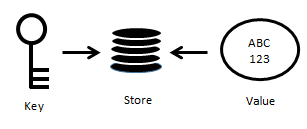Key-Value Store
What is a Key-Value Store?
A key-value store is a type of data storage software. It’s designed for storing, retrieving, and managing data as a set of unique identifiers with associated values. Its fundamental data structure is called the key-value pair. Every key maps to only one value in the collection. Each entry’s unique identifier is the key, and the associated value is either the data that the key identifies or the location of that data.

Another name for the key-value store is a key-value database, and that’s what it is — a database. It usually holds a collection of objects, called records, with data points in various data fields. The data records have unique (primary) keys to retrieve and modify records quickly. The key-value store keeps values as binary large objects (BLOBs), removing the need for an index. It makes requests directly to the object in memory, storing, retrieving, and updating data using simple commands like GET, PUT, and DELETE.
What Makes It Useful?
Because of this database model’s simplicity, it’s fast, flexible, scalable, and easy to use. The key-value store database model comes in handy when dealing with large volumes of data. It can process constant streams of read and write operations with exceptional performance unmatched by traditional data paths.
As the number of site users increases and their data grows, it becomes a challenge for simple SQL tables to handle the data effectively. The key-value store is beneficial here, as it can perform more operations in a given amount of time than other database models. It’s also ideal for handling large amounts of unstructured data, which usually stall system performance when combined with a solid-state drive. Key-value stores can quickly scale up to more significant storage volumes or scale out to more storage servers.
Applications that access data stored in different channels or web servers need key-value stores to connect and work together efficiently. Key-value databases also make it easy to port from one operating system to another without modifying code or architecture. And, key-value databases can do this without the risk of severe disruptions as you would expect when dealing with everyday relational databases.
How Do You Apply It in the Real World?
As stated above, key-value stores are beneficial for read-write operations, where speed and performance are top priorities. Because of this, they’re a good fit for a wide range of applications.
Session Management and User Preference Storage
Developers use key-value stores to stash user session details and preferences in web applications. For example, they can hold and manage all individual player sessions in multiplayer online games.
E-Commerce
E-commerce sites can retrieve and apply user preferences and session details that the key-value store holds for targeted ads and recommendations when users visit a site.
In-Memory Data Caching
Developers can also use key-value databases to cache specific pieces of data that don’t require a regular update. Caching reduces the frequency of read and write operations to slower disk-based systems.
Apache Ignite and GridGain as a Key-Value Store
Ignite can be used as a key-value store because its storage engine keeps records as key-value pairs. Thus, Ignite supports key-value APIs. Ignite conforms to the JSR 107 specification, known as JCache. JCache is an existing standard Java API for caching data. It was developed by the Java Community Process so that different technologies can share a standard caching interface. Therefore, applications using Ignite can create and work with an in-memory distributed cache of objects.
Ignite supports persistence to external databases, including RDBMS, NoSQL, and Hadoop. This “pluggable persistence” helps optimize performance and scale since RAM stores all data. In addition to pluggable persistence, Ignite has a native persistence that you can toggle on and off. When enabled, the key-value store can hold and process data in the RAM and on disk.
GridGain is built on Ignite and provides performance improvements while reducing memory consumption. GridGain uses a distributed partitioned hash map in which every cluster node owns a slice of the whole data set. As the number of nodes increases, it can store more data and better use cluster resources. The system supports distributed atomicity, consistency, isolation, and durability of transactions. It also supports scan, continuous queries, and collocated processing.
Conclusion
In recent years, businesses have needed more than database technology to succeed. As developers, we know we must stay informed about the architecture, tools, and services available to meet our company’s needs. Key-value stores are useful for developers because of their flexibility and scalability. This database model processes constant streams of read and write operations, making it easier to work with large amounts of data.
As the leading edge of in-memory computing, Apache Ignite and GridGrain help us address those needs. They mediate challenges of working with large volumes of data through optimizing cluster usage and storing more data as our nodes grow. To learn more about how to leverage the power of Apache Ignite, sign up for free on GridGain Nebula and explore its capabilities.
Ready to learn more?
Explore our products and services →